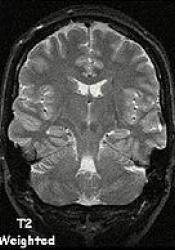Modern Anatomical Studies
Obviously, we have since come a long way since da Vinci's first dissection of a human corpse. The wealth of techniques we have available to us is rapidly increasing, as scientists develop new ways to probe the human form in an increasingly non-invasive manner. However, one of the most important tools in modern medicine is arguably the MRI machine, short for Magnetic Resonance Imaging. Relying on signals sent back by vibrating nuclei aligned by a massive magnet, an MRI is capable of producing a series of hundreds of images as though the patient's body had been "sliced" on countless paper-thin planes. Non-invasive and almost completely harmless, MRIs have become indispensable in the diagnosis of disease.
With such a technique, da Vinci's work has come under similar question to that of his predecessors. We are able to see structures in a living human patient that would not have been present in a cadaver multiple days old, such as the delicate tubes of the digestive tract and membranes like the omentum. However, as our advances continue, most of his observations continue to hold true - a testament to the care with which he made his initial drawings.
Sources:
"Leonardo da Vinci: anatomist." Jones, Roger.
Image source: https://en.wikipedia.org/wiki/File:T1t2PD.jpg

